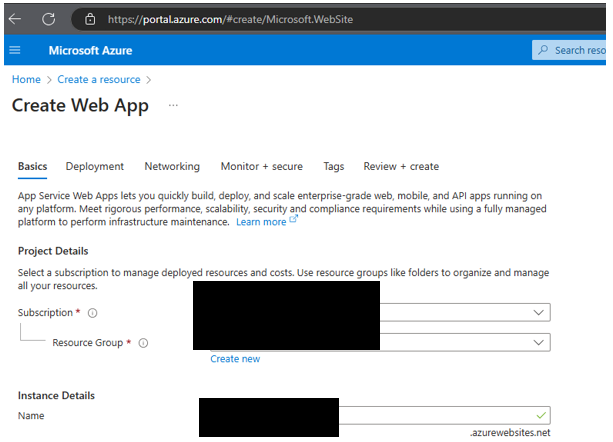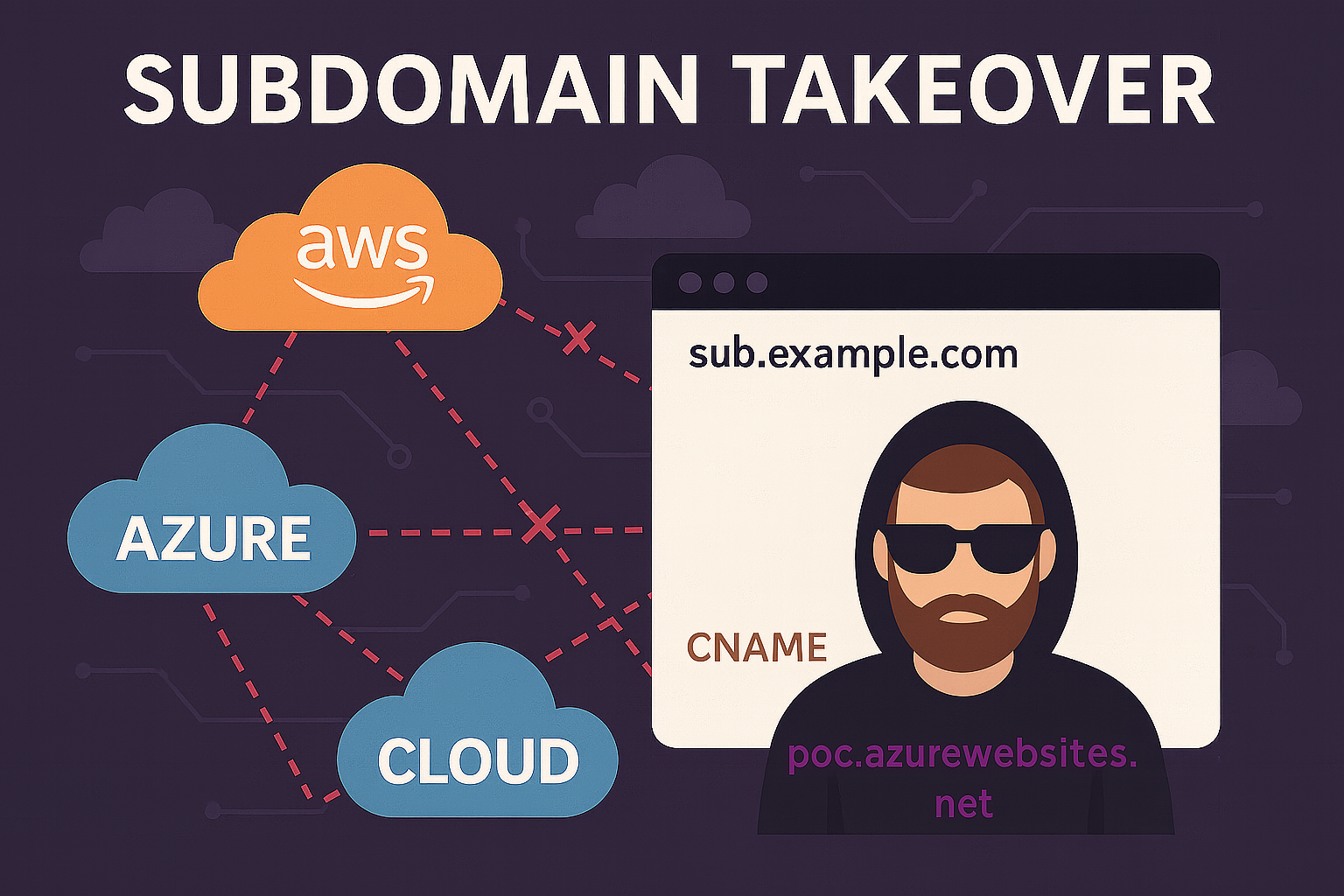Subdomain takeover: A deep dive into a common but overlooked cloud vulnerability
Disclaimer
This blog post is for educational and ethical hacking purposes only. I am not responsible for any misuse of the techniques described. Always seek explicit permission before testing domains or infrastructure that you do not own or operate. Any techniques discussed are intended solely for authorized red teaming, penetration testing, and responsible disclosure efforts.
What is a subdomain takeover?
A subdomain takeover occurs when a subdomain (like staging.example.com) points via DNS to a service that has not been claimed or was deleted but not cleaned up in DNS.
This allows an attacker to re-register the missing service and gain control over the subdomain. This is common with cloud providers such as Azure, AWS, etc.
Why subdomain takeover matters in red teaming and beyond
In red teaming or offensive security simulations, the goal is to think like an attacker - and attackers love low hanging fruit. One such vector is the subdomain takeover: it’s stealthy, high-impact, and surprisingly common, especially in cloud environments.
Subdomain takeovers often don’t require advanced exploit chains. They prey on poor hygiene, leftover DNS records, abandoned cloud services and lack of visibility. That’s why red teamers, bug bounty hunters, and cloud security engineers alike must understand and monitor for them.
The DNS + CNAME relationship in this attack
DNS stands for Domain Name System. It translates human readable domain names (like example.com) into IP addresses that computers use to identify each other.
In this context, CNAME records are a type of DNS record that allow a subdomain to point to another domain name, essentially creating an alias. For example, blog.example.com might be a CNAME pointing to example-blog.azurewebsites.net.
It becomes a security risk when DNS references (such as CNAME records) persist after the associated cloud service or server is deleted. If the destination (like example-blog.azurewebsites.net) no longer exists, an attacker can register that service and take control of the subdomain (blog.example.com).
CNAME stands for Canonical Name. This record can only point to other domain names, not directly to IP addresses.
A subdomain takeover occurs when a subdomain, which is linked to a service via a CNAME record, is taken over by an attacker. This happens because the service provider no longer uses that subdomain, but the CNAME record in the DNS hasn’t been removed.
How subdomain takeovers work
- A subdomain has a
CNAMErecord pointing toorphaned-service.cloudprovider.com - The target (
example-blog.azurewebsites.net) is unclaimed - The
CNAMEstill exists and resolves - The attacker registers and takes control of the unclaimed service, then uses the subdomain to serve their content.
How to detect a vulnerable subdomain
To begin, gather a list of subdomains using tools like amass or subfinder. Then, check if any of them contain CNAME records pointing to cloud services. Cross-reference with the status in Can I Take Over XYZ. If the status is Vulnerable and the fingerprint matches (e.g., NXDOMAIN), the subdomain is likely vulnerable to takeover.
What is NXDOMAIN?
It means “Non-Existent Domain”, DNS attempted to resolve a domain name but found no valid target. If your subdomain’s CNAME points to a service that returns NXDOMAIN, it’s likely vulnerable to takeover.
Here’s how you can manually check whether a subdomain is vulnerable:
Step 1: Check the CNAME record
1
dig subdomain.example.com
Look for a response like:
1
2
;; ANSWER SECTION:
subdomain.example.com. 300 IN CNAME poc.azurewebsites.net.
Step 2: Check if the CNAME target is available or dead
1
dig A poc.azurewebsites.net
If you see:
1
;; ->>HEADER<<- opcode: QUERY, status: NXDOMAIN, id: 12345
That means the CNAME target does not exist, a key indicator that this is a dangling record.
How to confirm via Azure Portal
To confirm if a dangling Azure subdomain is available, go to
https://portal.azure.com and log in with your credentials.
In the case of .azurewebsites.net, you can try creating a new Web App with the exact name of the unclaimed subdomain.
If it’s available, Azure will show a green checkmark confirming that the subdomain can be registered — meaning it’s vulnerable to takeover.

Screenshot: Azure Web App creation confirms the dangling subdomain is available to register (.azurewebsites.net shows a green checkmark).
💡 Tip
To confirm availability manually, try registering the same name in Azure’s Web App interface. A green checkmark means the subdomain is available — and likely vulnerable.
Optional: Use tools to automate this
For a broader overview of available tooling and research, explore:
Signature checks are performed by these tools to detect services susceptible to takeovers.
Real world examples of impact
Uber (2017) — Subdomain takeover on
rider.uber.comdue to non-existent CloudFront distribution.
[HackerOne Report #175070]Zenly (Snap Inc.) — Subdomain takeover of
brand.zen.lydue to unclaimed external service.
[HackerOne Report #1474784]
Attackers can serve phishing sites, malicious scripts, spread malware or use C2 beacons from a domain the victim trusts.
In a supply chain scenario, this could mean stealing credentials, breaking CSP policies, or hijacking trusted OAuth redirect URIs.
Attack vectors enabled by subdomain takeover
Once an attacker gains control of the subdomain, they can:
- Serve malicious HTML, JS, or phishing pages
- Capture cookies (if misconfigured)
- Abuse
*.example.comwildcard trust relationships - Spoof emails (if SPF/DKIM/DMARC are misconfigured)
- Use the domain in OAuth redirect URI attacks
- Host malware while appearing as a trusted domain
How to mitigate subdomain takeovers
The best defense is prevention through visibility and systematic hygiene:
Inventory and monitor
- Maintain a live inventory of all active subdomains
- Detect DNS records that point to external third party platforms
Remove dangling records
- Delete CNAME/A records pointing to services you no longer use
- Clean up test environments during decommissioning
Claim and reclaim
- If a subdomain is unused but still resolves — either remove the DNS record or reclaim the service
Monitor for NXDOMAINs
- Use DNS monitoring tools (e.g., SecurityTrails, DNSDB, PassiveTotal) to detect NXDOMAIN responses on your infrastructure
Automate continuous testing
- Run scheduled scans with tools like
amassto detect changes in DNS resolution and service ownership
Advanced tip: preventive DNS sinkholing
For subdomains you don’t plan to use but want to reserve, you can redirect them to a sinkhole or dummy service you own. This prevents attackers from being able to claim the associated CNAME target.
Resources worth bookmarking
Azure Subdomain Takeover Guide by Stratus Security
A comprehensive write-up on how Azure-based subdomain takeovers occur and how to secure against them.Can I Take Over XYZ? by EdOverflow
A curated list of services known to be vulnerable or safe from takeover when misconfigured. Regularly updated.Can I Take Over DNS? by indianajson
A list of DNS providers and whether their zones are vulnerable to DNS takeover.Subdomain Takeover in AWS: Making a PoC
A hands-on walkthrough of subdomain takeover using AWS services.Google Admin Toolbox: DIG Tool
Use this tool to inspect CNAME records in a browser.
TL;DR recap for offensive security practitioners
- Look for dangling CNAMEs pointing to third-party platforms
- Confirm the target returns
NXDOMAINor similar - Attempt to claim the target only if authorized (e.g., in red teaming or bug bounty)
- Impact can be high severity, especially in OAuth, SSO, or CDN contexts
- Mitigate by inventorying, monitoring, and cleaning DNS records regularly
So, as we wrap up our dive into subdomain takeovers, remember this: in the fast paced world of cloud environments and ever evolving threats, our best defense is to be proactive. Stay alert in monitoring your digital footprint, automate your detection efforts whenever possible to catch those tricky dangling records, and if you uncover a vulnerability, always prioritize responsible disclosure (efforts by the community). By adopting these practices, we can collectively make the internet a safer place, one subdomain at a time.
